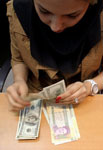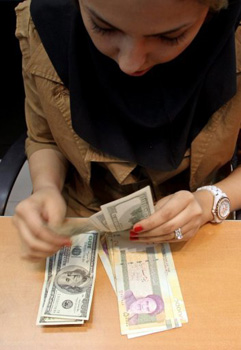 Reuters: Iran’s central bank announced a raft of measures to prop up the rial currency on Wednesday after a rush for dollars forced a devaluation.
Reuters: Iran’s central bank announced a raft of measures to prop up the rial currency on Wednesday after a rush for dollars forced a devaluation.
By Robin Pomeroy
 TEHRAN, June 15 (Reuters) – Iran’s central bank announced a raft of measures to prop up the rial currency on Wednesday after a rush for dollars forced a devaluation.
TEHRAN, June 15 (Reuters) – Iran’s central bank announced a raft of measures to prop up the rial currency on Wednesday after a rush for dollars forced a devaluation.
The measures, including raising domestic interest rates, come after the bank said earlier this week it was injecting billions of dollars into the market to stabilise the currency.
Central Bank Governor Mahmoud Bahmani said the Islamic Republic would also issue more bonds and abolish a sales tax on gold to make other investments more appealing to Iranians who have rushed to buy dollars in recent weeks, depressing the value of the rial.
“We have used (only) one of our tools to control the market,” Bahmani told state TV news, referring to the currency intervention. “We are going to use all of our tools to create a balanced market.”
While high prices for Iran’s oil exports will have replenished its foreign exchange reserves, analysts say a sanctions campaign, led by Western states, that has made cross-border financial transactions more difficult has contributed to pressure on the rial.
“The last round of sanctions by the U.S. and Europe have been quite severe and the first time sanctions began to make a difference in the capacity of Iran to operate internationally. It is being squeezed,” said George Abed of the Washington-based Institute of International Finance.
CASH SUBSIDIES
Central bank chief Bahmani had already announced that Iran would inject between $1.5 billion and $3 billion into the market every week to support the rial after the bank devalued it by more than 10 percent a week earlier.
Rising inflation, a reduction in bank interest for savers and a new value-added tax on gold coins have all pushed Iranians to seek hard currency as a safe haven for their wealth.
Allowing banks to pay higher interest rates on savings would be a U-turn from the central bank’s decision in April to slash rates from a range of 26-28 percent to 14-17 percent, below what many Iranians believe to be the real inflation rate.
Many economists believe the rial, which is loosely pegged to major world currencies under a “managed float”, has not been allowed to devalue in line with inflation and is over-valued by at least 30 percent.
“The rial had been appreciating against the dollar for almost a decade considering Iran’s inflation rate of about 20 percent per year,” said Nassir Shirkhani, a Beirut-based analyst.
“The recent weakness of the rial is partly a reflection of the inflationary pressures and also the fact that the government has been printing money to pay cash subsidies to the population.”
At the end of last year, President Mahmoud Ahmadinejad started phasing out the $100 billion annual subsidies that had held down prices of essentials like food and fuel and began giving direct cash payments to families to reduce the impact of price rises.
The price of bread has doubled and gasoline costs up to seven times what it did before the subsidies were slashed last year.
The International Monetary Fund commended the subsidy cuts and said that inflation had fallen to 12.4 percent in the last Iranian year from 25.4 percent two years earlier.
But may Iranians doubt the official inflation figure which in any case has risen steadily over the last year to 14.2 percent last month. The official food inflation figure stands at 25 percent.
“FAKE” EXCHANGE RATE
Djavad Salehi-Isfahani, Professor of Economics at Virginia Tech in the United States, said Iran was propping up the rial — which he believes is over valued by 50 percent — to try to avoid soaring inflation as the subsidy reform takes effect.
“The only reason why at this time it is important to prevent the rial from devaluing too much is to prevent inflation that would undo the subsidy reform. The success of that reform is riding on keeping inflation down at this point,” he said.
When asked whether the rial could crash despite the raft of new policies, he said: “I doubt the Central Bank can support an undervalued currency for long. (It will) not crash but will adjust.”
The Central Bank’s reference rate was 11,501 rials to the dollar on Wednesday, the strongest since last week’s devaluation where it soared to 11,717 from 10,5999 when it devalued, according to its website.
Iranians are allowed to buy up to $2,000 at that rate if they present their passports and flight tickets showing they are travelling abroad.
Otherwise they must buy hard currency on the open market where prices had also calmed to 12,000 rials per dollar, from 12,500 on Monday, according to the financial website Mesghal.ir.
Bahmani said the government was considering restricting the sale of dollars to airports, making it harder for people to convert their savings into hard currency in the high street, a practice he said was causing a speculative “fake” exchange rate.
(Additional reporting by Ramin Mostafavi and by Martina Fuchs and Martin Dokoupil in Dubai; writing by Robin Pomeroy; editing by Patrick Graham/Ruth Pitchford)


